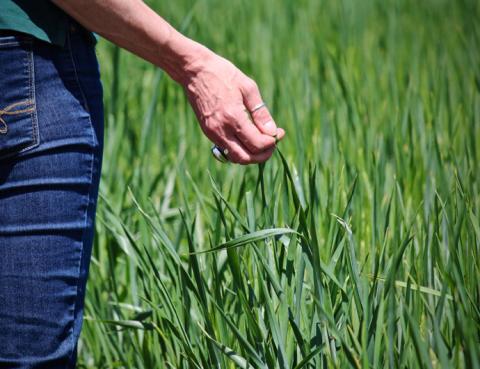Field of Greens
Double-Cropping Trial Proves Viability of Winter Triticale in New Hampshire
SHARE

Many New Hampshire farmers resist the idea of trading their tried-and-true full-season silage corn variety for one with a shorter growing season. But Adam Crete, owner of his family's Highway View Farm in Boscawen, jumped at the chance to try something new as part of a double-cropping research trial led by Cooperative Extension.
Last year, Crete planted 60 acres of a corn variety that matured in 95 days. He harvested the corn in early September and then planted winter triticale (pronounced trit-ih-KAY-lee), a hardy hybrid of wheat and rye that is nutritious and easily digestible. A conservation and innovation grant from the Natural Resources Conservation Service (NRCS) helps fund the project, which is led by Extension’s Carl Majewski, Daimon Meeh and Steve Turaj.
Majewski says farmers like Crete should consider planting forage crops year round. Double-cropping helps prevent erosion, reduces nutrient loss and increases organic matter in the soil. It also may provide insurance for farmers. Long-season corn isn’t harvested until early fall, so it is vulnerable to frosts and unpredictable weather that could damage yields. It's also harvested too late to establish a winter cover crop. Short-season corn is harvested before frosts, allowing farmers to then plant a cover crop, like triticale, which provides supplemental feed.
According to Iago Hale, assistant professor of specialty crop improvement at the University of New Hampshire's College of Life Sciences and Agriculture and a researcher with the N.H. Agricultural Experiment Station, many of the state’s farmers are still wary that double-cropping will result in feed shortages.
"The reputation of short-season corn [yielding less than long-season corn] was well-deserved a couple decades ago," says Hale. "That isn't true any longer. Shorter-season hybrids have been developed that are very competitive. From a cost-benefit perspective, short-season corn as a component of a year-round forage production system is a huge win."
That's why in 2014, Majewski, Meeh and Turaj partnered with Hale in an effort to change farmers' minds. Six farms in New Hampshire, including Highway View, agreed to implement a double-cropping system that coupled short-season silage corn with fall-planted triticale. Last spring, Majewski, Meeh, and Hale met with other New Hampshire farmers and staff from the USDA, NRCS, and the New Hampshire Department of Agriculture at Highway View Farm, home to 220 hungry cows, to gauge the project's success.
Crete is pleased with the results of the double-cropping system. His 95-day silage corn yield was comparable to the longer-maturing variety he used. On top of that, he expects to harvest about two tons of triticale per acre. After harvesting the triticale, he can drill in his corn seed without tilling — an added benefit.
Buoyed by the research trial’s success, Majewski hopes more farms will adopt double-cropping. To help interested farmers, he provides one-on-one support and harvesting recommendations.
"Double cropping represents a great opportunity to reduce feeding costs and improve bottom lines for New Hampshire farmers, but making the transition isn’t without risk," says Majewski. "That's why the research and support Extension provides is so valuable. Helping our farmers be successful impacts their families, their farms, their employees, and, ultimately, the state."
This story originally appeared in the 2017 edition of Radius.
